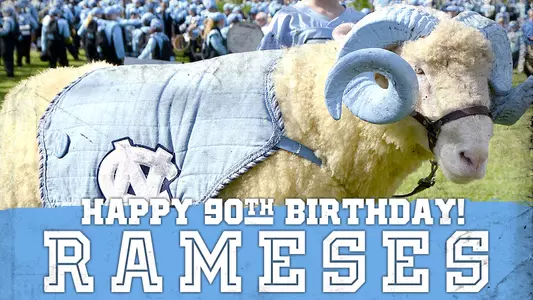University of North Carolina Athletics

Happy Birthday, Rameses!
November 7, 2014 | General
By UNC Athletic Communications, with additional reporting by Turner Walston
He saw Gio's punt return. He saw Connor's kick. He saw Dre' Bly and Julius Peppers, Chris Keldorf and T.J. Yates, LT, Charlie Justice, Chris Hanburger and William Fuller. He's been a constant on the sideline at Kenan Stadium. Saturday marks the 90th birthday of Carolina's beloved ram mascot, Rameses.
With a team called the Tar Heels, it might seem strange that a ram is Carolina's mascot. Vic Huggins, Carolina's head cheerleader in 1924, offered an explanation."In 1924 school spirit was at a peak," Huggins once said, “but something seemed to be missing. One day it hit me: State had a wolf. What Carolina needed was a symbol."
Two years earlier, the Tar Heels had posted a brilliant 9-1 record on the back of a bruising fullback named Jack Merritt. Merritt was nicknamed "The Battering Ram" for the way he plunged into lines. To Huggins, it seemed natural to link a mascot with Merritt's unusual sobriquet.
“Charlie Woollen, the athletic business manager at that time, agreed with the idea and gave us $25 to purchase a fitting mascot,” Huggins said. Rameses I was shipped in from Texas, arriving just in time to be introduced at a pep rally before the VMI game. Complete with a monogram blanket on his back, Rameses helped make the pep rally one of the school's greatest.
Then, the ram was taken to Emerson Field, where Carolina was an underdog to a strong Keydet team. But, for three quarters, the Tar Heels battled the visitors to a scoreless tie.
Late in the fourth quarter, Carolina's Bunn Hackney was called upon to attempt a field goal. Before taking the field, he stopped to rub Rameses' head for good luck. Seconds later, Hackney's 30-yard dropkick sailed between the goalposts, giving the Tar Heels a 3-0 victory and a legendary mascot.
Ninety years later, the ram that fans now see at home games is Rameses XX, fitting for the 20th dorset horned sheep to take the mantle. The Hogan family has cared for Rameses for 90 years. Don Basnight is a third-generation caretaker, the grandson of Henry Hogan, who looked after Rameses I.
When selecting the next ram to become Rameses, the family looks for a symmetrical curl in the horns. “Every animal doesn't have that same symmetry and broad horns, so we look for that,” Basnight said. “[Then], temperament, if we get to choose. We like to use animals that are gentler and easier to work with, because they're rams, and they will butt you.”
Before a game (Friday night or early Saturday), the caretakers brush out Rameses' coat, wash him if necessary, and paint the horns. “A nice Carolina blue latex,” Basnight said. Game day involves touching up the paint, putting on the bridle and halter and blanket and heading to town. Rameses rides down Franklin Street and stopping by fraternity and sorority houses and tailgate parking lots before hitting Tar Heel Town.
“We often will see the same people,” Basnight said. “They'll come up and say they've got to pet him as their own superstition, their own game day ritual. They've got to pet the ram before the game, and that's a lot of fun. People will introduce themselves and often share a ram experience, where they've seen him with maybe one of the other caretakers through the years. It's a family tradition that they have from when they were in school.”
Rick Steinbacher, Carolina senior associate athletic director for marketing, said the Rameses tradition is a special one. “It's always such a thrill to see how much all of our fans, particularly our young fans, enjoy meeting and interacting with Rameses at Tar Heel Town and at Kenan Stadium,” he said. “For me personally, it's been a real joy to get to know the Hogan family and all the folks that have kept the tradition going for so long. They take a great deal of pride in it, they do a great job taking care of Rameses and being a part of football Saturdays.”
In addition to home games, Rameses has traveled everywhere from New York City (for the Carolina-Notre Dame game in 1949) to Jacksonville for Carolina's Gator Bowl appearances.
“We've been in it a long time,” Basnight said. “I think it's one of the best traditions for a mascot in our nation. It really speaks to our school and the history of our athletics, and particularly our football program.”
